A ROYAL CATFIGHT
GETS A ROYAL PRODUCTION
Coulda, woulda, shoulda: It’s the greatest confrontation between rival monarchs that never happened — the 1586 face-off between the “Virgin” Queen Elizabeth and the younger, thrice-wed Mary Queen of Scots (whose son, ironically, would inherit the disputed throne). In hindsight it seems a no-brainer: The cousins should have had a direct encounter, M’s pretty face to E’s painted one. If opposites attract, they’d collide like comets.
But, if history lacked the imagination to satisfy our retroactive curiosity, literature doesn’t. The fix came in 1800 from Friedrich Schiller, whose magnificent make-over Mary Stuart would later inspire Gaetano Donizetti to turn historical speculation into grand opera. Now, in a taut and pulverizing 2005 adaptation by Peter Oswald, and a theatrically thrilling staging by Jenn Thompson, this nearly three-hour tour-de-reines ignites Chicago’s Navy Pier. If politics is personal, this power-playing “game of thrones” seems cunningly current.
If Shakespeare never wrote a play about his contemporaries Mary and Elizabeth, Schiller’s kinetic masterpiece is the next best thing — and who better to bring it to us but Chicago Shakespeare Theater?
Played against the severe walls of Andromache Chalfant’s prison/palace, Mary Stuart could have been reduced to a melodramatic squabble between literal drama queens: Schiller provides enough psychological pyrotechnics between his dueling divas for a dozen WWF cage matches. But overlaying this excellent endeavor is a guiding intelligence. It marvels at history’s twists (as much as those of the plot) and the stunning polarities that compel two incontestably independent women to destroy each other over faith and the future.
It’s a showdown that, given their diametrically detrimental differences, practically writes itself. Like the proverbial Dodge City, the British Isles weren’t big enough to hold the both of them. Artfully engaged several times but married to no one but England, tough-loving, battle-hardened Elizabeth (the charmingly complicated Kellie Overbey) was once declared a bastard and disinherited for her half-brother. Surviving the religious persecutions of her half-sister “Bloody Mary,” she has now reigned for a quarter century, escaping three assassination attempts and the rancor of a Catholic minority ever ready to rebel. Denying and defying the supposed weakness of a woman, she instinctively refuses a husband who might well reduce her queendom to the usual dispensation.
Where the last of the Tudors is duty-driven, secretive, and calculating to the last chess move, the ostentatiously Catholic Mary (an explosively emotional K.K. Moggie) is an impetuous, freedom-loving life force. In her crowded career Mary was queen of two countries. Separated from her first hubbie, the Dauphin of France, she later had her second husband Thomas Riccio murdered at Holyrood Palace, then married Darnley, the man who killed him (and who was later literally blown up). Seeking sanctuary from Scotland’s ire, miserable Mary finds captivity instead at Fotheringhay Castle. Alas, her long imprisonment makes her the perfect pseudo-martyr to inspire a Catholic coup and/or Spanish invasion (which in fact did occur, two years after her execution, with the arrival of the Armada).
For both women this untenable situation is fraught with peril. Will Elizabeth justify her own possible assassination by putting to death a consecrated ruler who was not judged by her peers and who most of Europe supports? Or will mercy be confused with weakness and create a self-fulfilling prophecy of doom?
Schiller employs the entire first act to set up an imaginary meeting that takes place, sardonically enough, while Elizabeth is on the hunt near Mary’s dour dungeon. The set-up is worth the pay-off as the fur flies.
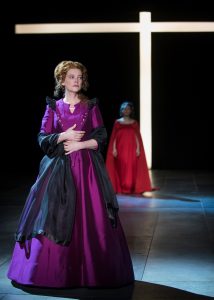 Pawns and more, the other chess pieces in this clash of the titans are the ladies’ “enablers”: Andrew Chown depicts scheming Mortimer, Mary’s ardent Catholic adorer and an inept conspirator, while Tim Decker is Elizabeth’s beloved Leicester, a “double agent” who was equally stupidly smitten with Mary as he clumsily plays off one queen against the other.
Pawns and more, the other chess pieces in this clash of the titans are the ladies’ “enablers”: Andrew Chown depicts scheming Mortimer, Mary’s ardent Catholic adorer and an inept conspirator, while Tim Decker is Elizabeth’s beloved Leicester, a “double agent” who was equally stupidly smitten with Mary as he clumsily plays off one queen against the other.
Other cat’s-paws in this endgame are Mary’s spitfire champion and confidante Hanna Kennedy (Chicago treasure Barbara Robertson); Mary’s reluctantly sympathetic jailer Amias Paulet (always excellent Kevin Gudahl); and the philosophically moderate George Talbot (avuncular Robert Jason Jackson), confusedly caught in the crossfire and pleading with his queen not to succumb to vile vengeance.
Fueling this pot-boiler are incriminating letters sent by Mary to influence the outcome: Foolishly and fatally, they end up in the wrong hands. These misfires force Elizabeth’s hand, though her almost anguished ambivalence over signing the death warrant and seeing it carried out — to her two entirely separate matters — is unintentionally hilarious.
In the play’s radiant apotheosis, an unrepentant and heaven-bent Mary, too proud for pity and secretly given extreme unction, as well as last rites, absolution and communion, goes to glory. Too late Elizabeth discovers that Mary was above collusion, corruption, and the treason of regicide. She’s all but abandoned because it’s lonely at the top.
Mary Stuart is as convulsive a roller-coaster rouser as plays get, galvanizing immovable adversaries propelled by irresistible forces. Schiller shrewdly manages to raise the stakes in every scene to the highest risk.
Respecting the poetry but purging the rhetoric, Oswald’s pile-driving text is theatrical manna for C.S.T.’s thirteen thespians. But, of course, Moggie and Overbey steal the show, their regal catfight a scenery-scorching, roof-raising, one-ring-circus war of words. If it didn’t happen, it should have. Art lives to improve on reality. Proceed to the Pier.
photos by Michael Brosilow
Mary Stuart
Chicago Shakespeare Theater
The Jentes Family Courtyard Theater on Navy Pier, 800 E. Grand Ave.
Tues-Fri at 7:30, Sat at 3 and 8, Sun at 2
ends on April 15, 2018
for tickets, call 312.595.5600 or visit Chicago Shakes
for more shows, visit Theatre in Chicago
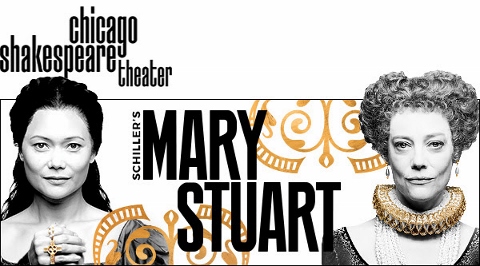
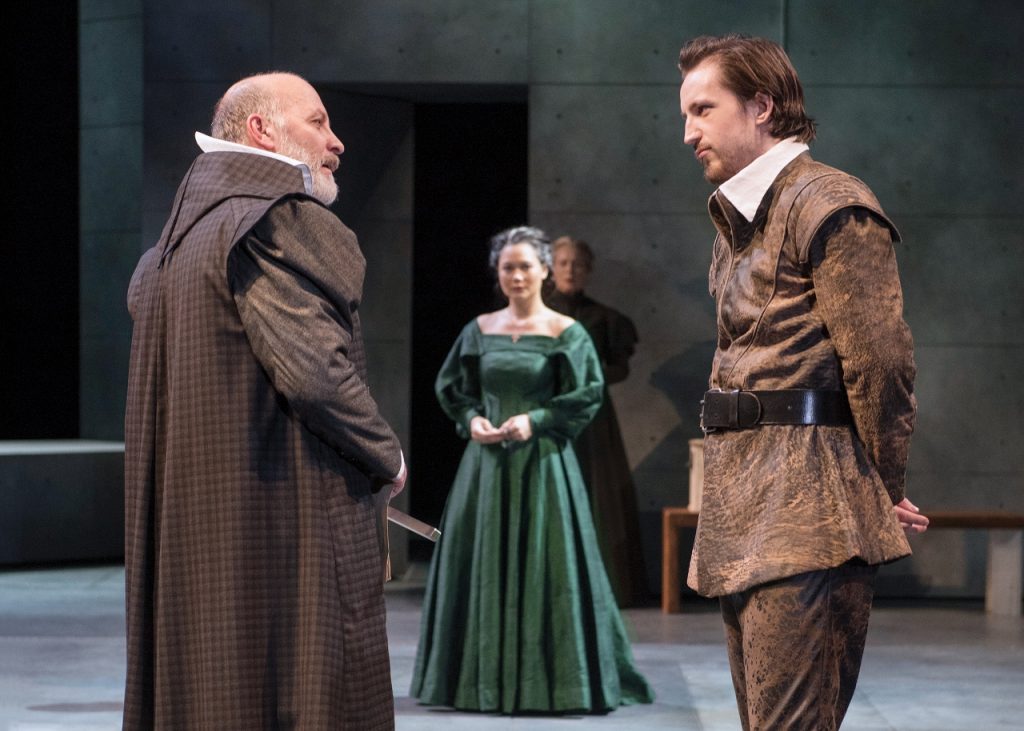
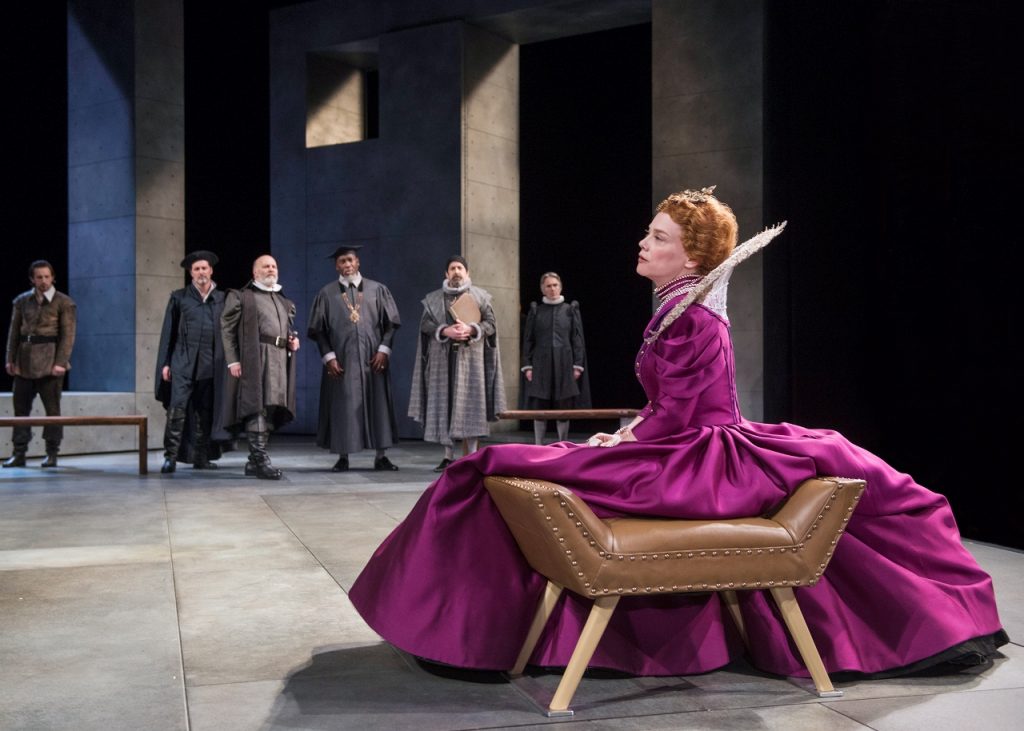
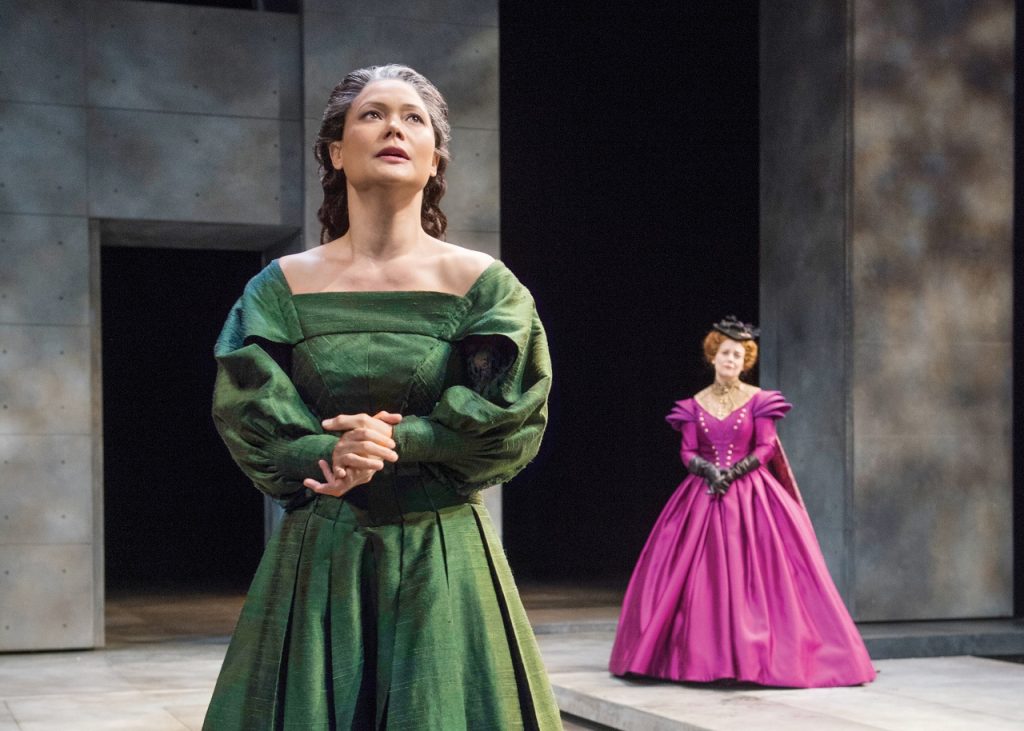
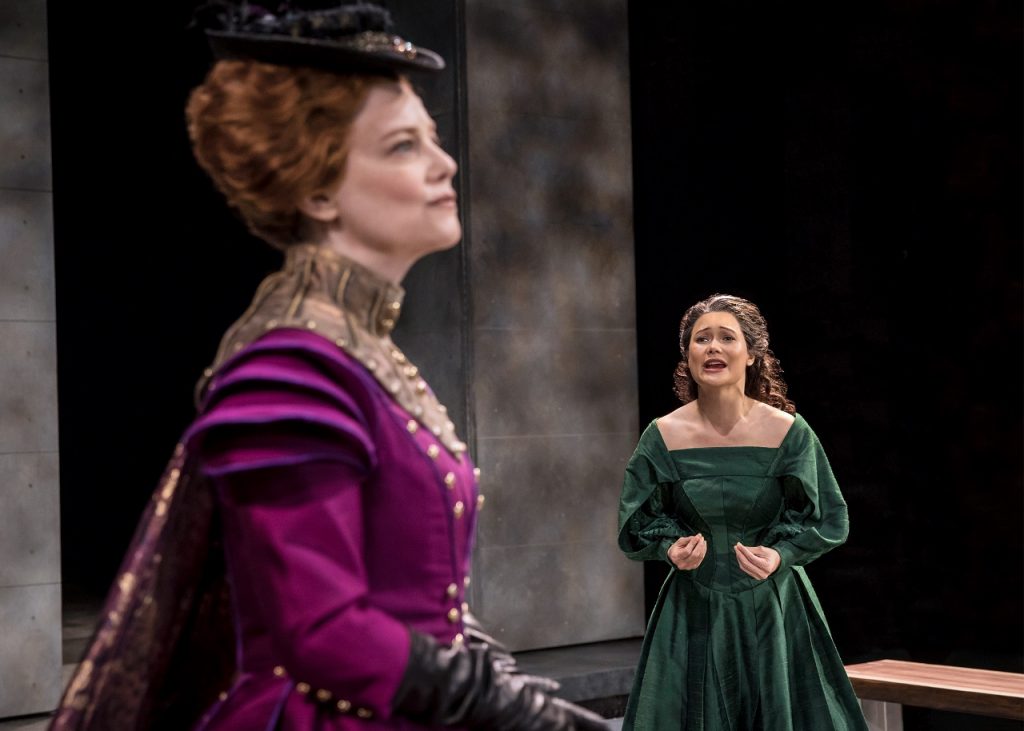

{ 2 comments… read them below or add one }
Please look at your history — there was no Second husband named Thomas Riccio. David Riccio was her private secretary who Darnley had murdered in front of her. Assisted by Thomas Howard. Her first husband died — they were no separated — he died two years after their marriage. Her third husband was Earl of Bothwell who was also implicated in the Casket Letters. Please if you are going to use “history” to make character judgments, then please use correct history.
Thanks for the correction. I should not have relied on memory alone. But, as long as I am, it was so creepy for me, many years ago, to stand in the same nchambers in Holyrood Castle where Riccio was dragged to the slaughter.
In any case, I should have stuck to the immediate facts of the tragedy and not indulged in an inaccurate effort to provide an unneeded context.